2006 CHEVROLET CORVETTE ECU
[x] Cancel search: ECUPage 37 of 426
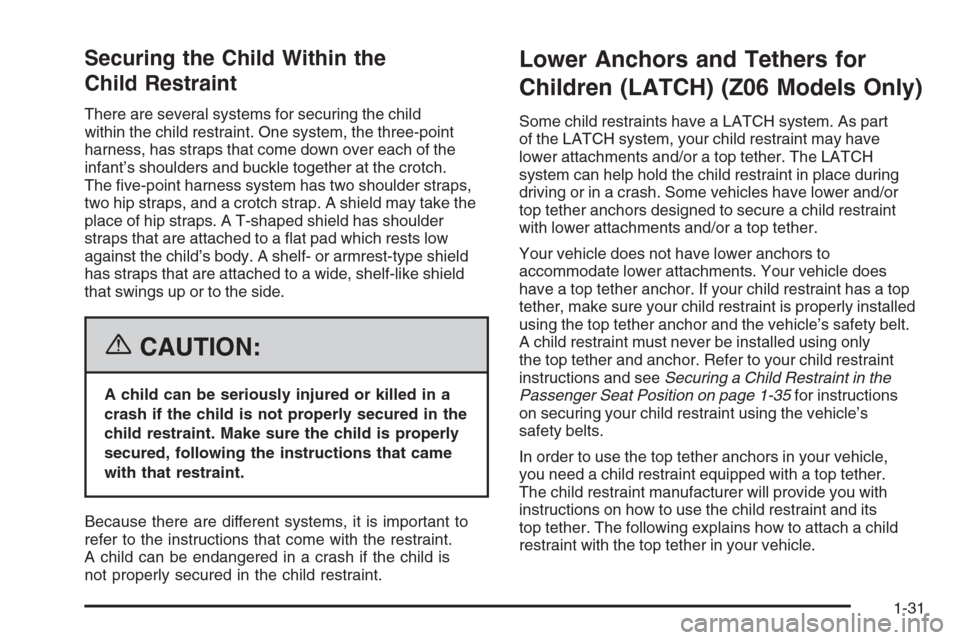
Securing the Child Within the
Child Restraint
There are several systems for securing the child
within the child restraint. One system, the three-point
harness, has straps that come down over each of the
infant’s shoulders and buckle together at the crotch.
The �ve-point harness system has two shoulder straps,
two hip straps, and a crotch strap. A shield may take the
place of hip straps. A T-shaped shield has shoulder
straps that are attached to a �at pad which rests low
against the child’s body. A shelf- or armrest-type shield
has straps that are attached to a wide, shelf-like shield
that swings up or to the side.
{CAUTION:
A child can be seriously injured or killed in a
crash if the child is not properly secured in the
child restraint. Make sure the child is properly
secured, following the instructions that came
with that restraint.
Because there are different systems, it is important to
refer to the instructions that come with the restraint.
A child can be endangered in a crash if the child is
not properly secured in the child restraint.
Lower Anchors and Tethers for
Children (LATCH) (Z06 Models Only)
Some child restraints have a LATCH system. As part
of the LATCH system, your child restraint may have
lower attachments and/or a top tether. The LATCH
system can help hold the child restraint in place during
driving or in a crash. Some vehicles have lower and/or
top tether anchors designed to secure a child restraint
with lower attachments and/or a top tether.
Your vehicle does not have lower anchors to
accommodate lower attachments. Your vehicle does
have a top tether anchor. If your child restraint has a top
tether, make sure your child restraint is properly installed
using the top tether anchor and the vehicle’s safety belt.
A child restraint must never be installed using only
the top tether and anchor. Refer to your child restraint
instructions and seeSecuring a Child Restraint in the
Passenger Seat Position on page 1-35for instructions
on securing your child restraint using the vehicle’s
safety belts.
In order to use the top tether anchors in your vehicle,
you need a child restraint equipped with a top tether.
The child restraint manufacturer will provide you with
instructions on how to use the child restraint and its
top tether. The following explains how to attach a child
restraint with the top tether in your vehicle.
1-31
Page 38 of 426
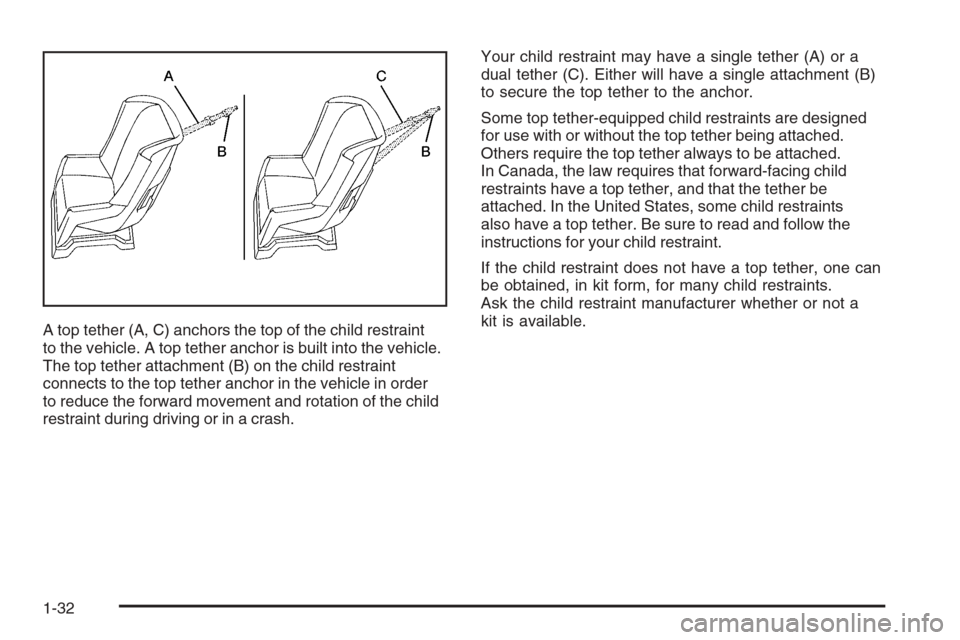
A top tether (A, C) anchors the top of the child restraint
to the vehicle. A top tether anchor is built into the vehicle.
The top tether attachment (B) on the child restraint
connects to the top tether anchor in the vehicle in order
to reduce the forward movement and rotation of the child
restraint during driving or in a crash.Your child restraint may have a single tether (A) or a
dual tether (C). Either will have a single attachment (B)
to secure the top tether to the anchor.
Some top tether-equipped child restraints are designed
for use with or without the top tether being attached.
Others require the top tether always to be attached.
In Canada, the law requires that forward-facing child
restraints have a top tether, and that the tether be
attached. In the United States, some child restraints
also have a top tether. Be sure to read and follow the
instructions for your child restraint.
If the child restraint does not have a top tether, one can
be obtained, in kit form, for many child restraints.
Ask the child restraint manufacturer whether or not a
kit is available.
1-32
Page 40 of 426
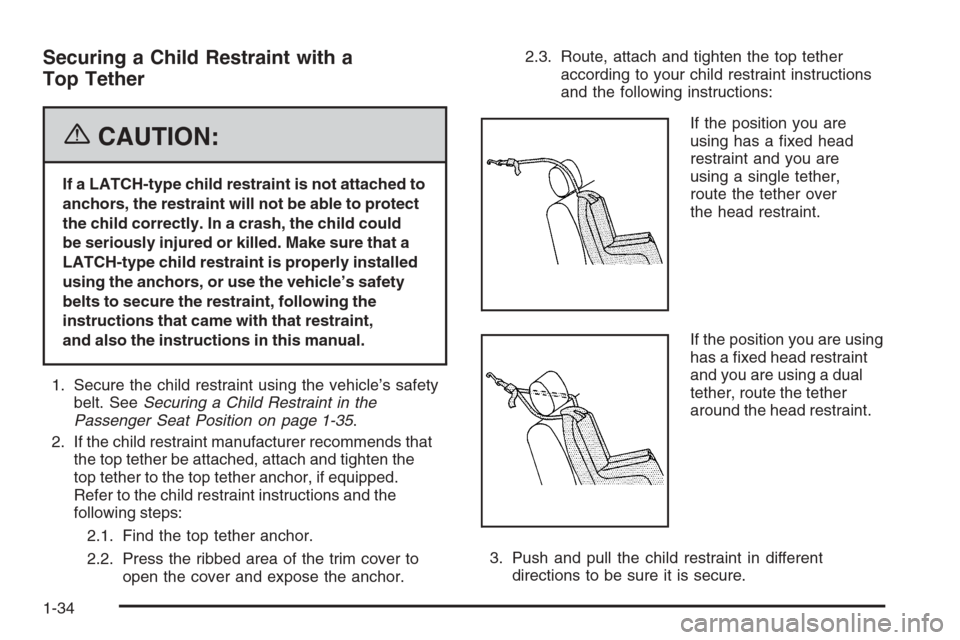
Securing a Child Restraint with a
Top Tether
{CAUTION:
If a LATCH-type child restraint is not attached to
anchors, the restraint will not be able to protect
the child correctly. In a crash, the child could
be seriously injured or killed. Make sure that a
LATCH-type child restraint is properly installed
using the anchors, or use the vehicle’s safety
belts to secure the restraint, following the
instructions that came with that restraint,
and also the instructions in this manual.
1. Secure the child restraint using the vehicle’s safety
belt. SeeSecuring a Child Restraint in the
Passenger Seat Position on page 1-35.
2. If the child restraint manufacturer recommends that
the top tether be attached, attach and tighten the
top tether to the top tether anchor, if equipped.
Refer to the child restraint instructions and the
following steps:
2.1. Find the top tether anchor.
2.2. Press the ribbed area of the trim cover to
open the cover and expose the anchor.2.3. Route, attach and tighten the top tether
according to your child restraint instructions
and the following instructions:
If the position you are
using has a �xed head
restraint and you are
using a single tether,
route the tether over
the head restraint.
If the position you are using
has a �xed head restraint
and you are using a dual
tether, route the tether
around the head restraint.
3. Push and pull the child restraint in different
directions to be sure it is secure.
1-34
Page 41 of 426
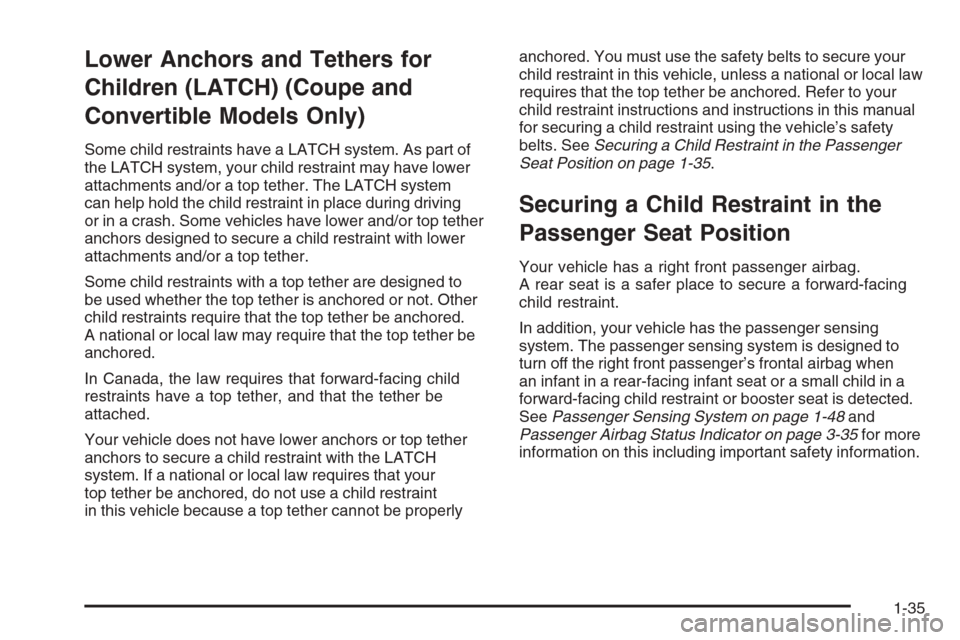
Lower Anchors and Tethers for
Children (LATCH) (Coupe and
Convertible Models Only)
Some child restraints have a LATCH system. As part of
the LATCH system, your child restraint may have lower
attachments and/or a top tether. The LATCH system
can help hold the child restraint in place during driving
or in a crash. Some vehicles have lower and/or top tether
anchors designed to secure a child restraint with lower
attachments and/or a top tether.
Some child restraints with a top tether are designed to
be used whether the top tether is anchored or not. Other
child restraints require that the top tether be anchored.
A national or local law may require that the top tether be
anchored.
In Canada, the law requires that forward-facing child
restraints have a top tether, and that the tether be
attached.
Your vehicle does not have lower anchors or top tether
anchors to secure a child restraint with the LATCH
system. If a national or local law requires that your
top tether be anchored, do not use a child restraint
in this vehicle because a top tether cannot be properlyanchored. You must use the safety belts to secure your
child restraint in this vehicle, unless a national or local law
requires that the top tether be anchored. Refer to your
child restraint instructions and instructions in this manual
for securing a child restraint using the vehicle’s safety
belts. SeeSecuring a Child Restraint in the Passenger
Seat Position on page 1-35.
Securing a Child Restraint in the
Passenger Seat Position
Your vehicle has a right front passenger airbag.
A rear seat is a safer place to secure a forward-facing
child restraint.
In addition, your vehicle has the passenger sensing
system. The passenger sensing system is designed to
turn off the right front passenger’s frontal airbag when
an infant in a rear-facing infant seat or a small child in a
forward-facing child restraint or booster seat is detected.
SeePassenger Sensing System on page 1-48and
Passenger Airbag Status Indicator on page 3-35for more
information on this including important safety information.
1-35
Page 42 of 426
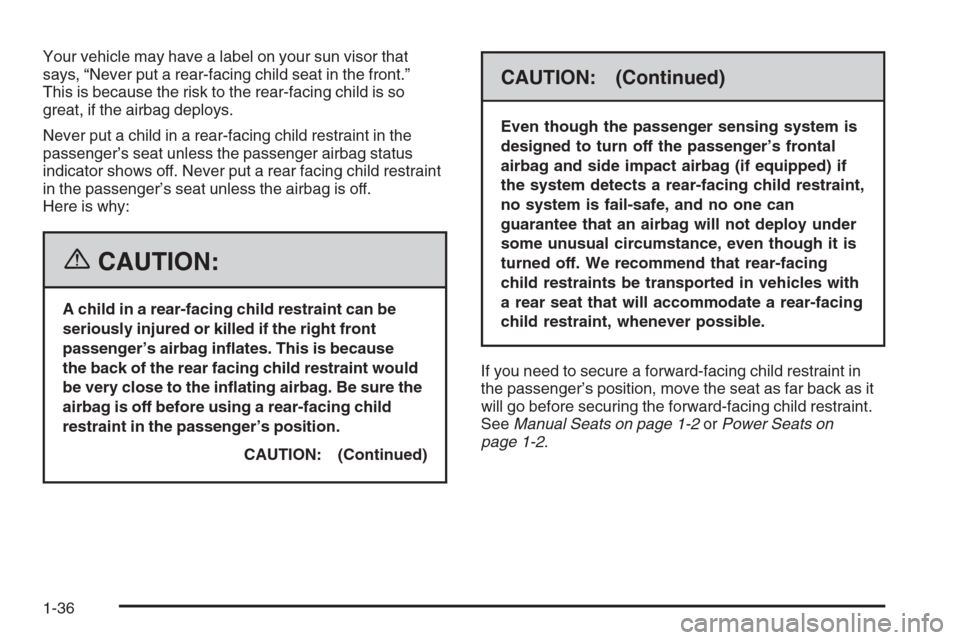
Your vehicle may have a label on your sun visor that
says, “Never put a rear-facing child seat in the front.”
This is because the risk to the rear-facing child is so
great, if the airbag deploys.
Never put a child in a rear-facing child restraint in the
passenger’s seat unless the passenger airbag status
indicator shows off. Never put a rear facing child restraint
in the passenger’s seat unless the airbag is off.
Here is why:
{CAUTION:
A child in a rear-facing child restraint can be
seriously injured or killed if the right front
passenger’s airbag in�ates. This is because
the back of the rear facing child restraint would
be very close to the in�ating airbag. Be sure the
airbag is off before using a rear-facing child
restraint in the passenger’s position.
CAUTION: (Continued)
CAUTION: (Continued)
Even though the passenger sensing system is
designed to turn off the passenger’s frontal
airbag and side impact airbag (if equipped) if
the system detects a rear-facing child restraint,
no system is fail-safe, and no one can
guarantee that an airbag will not deploy under
some unusual circumstance, even though it is
turned off. We recommend that rear-facing
child restraints be transported in vehicles with
a rear seat that will accommodate a rear-facing
child restraint, whenever possible.
If you need to secure a forward-facing child restraint in
the passenger’s position, move the seat as far back as it
will go before securing the forward-facing child restraint.
SeeManual Seats on page 1-2orPower Seats on
page 1-2.
1-36
Page 43 of 426
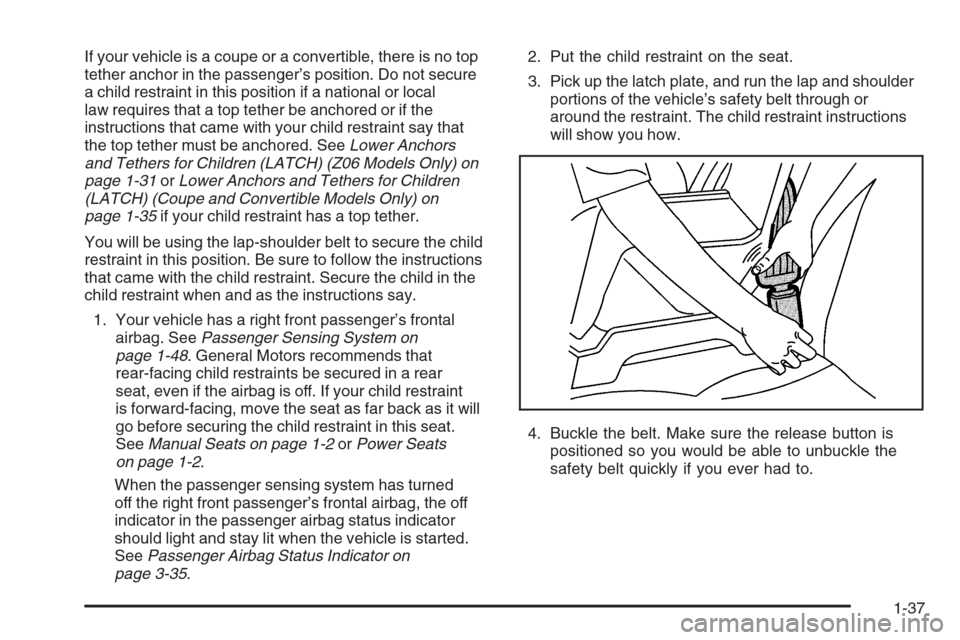
If your vehicle is a coupe or a convertible, there is no top
tether anchor in the passenger’s position. Do not secure
a child restraint in this position if a national or local
law requires that a top tether be anchored or if the
instructions that came with your child restraint say that
the top tether must be anchored. SeeLower Anchors
and Tethers for Children (LATCH) (Z06 Models Only) on
page 1-31orLower Anchors and Tethers for Children
(LATCH) (Coupe and Convertible Models Only) on
page 1-35if your child restraint has a top tether.
You will be using the lap-shoulder belt to secure the child
restraint in this position. Be sure to follow the instructions
that came with the child restraint. Secure the child in the
child restraint when and as the instructions say.
1. Your vehicle has a right front passenger’s frontal
airbag. SeePassenger Sensing System on
page 1-48. General Motors recommends that
rear-facing child restraints be secured in a rear
seat, even if the airbag is off. If your child restraint
is forward-facing, move the seat as far back as it will
go before securing the child restraint in this seat.
SeeManual Seats on page 1-2orPower Seats
on page 1-2.
When the passenger sensing system has turned
off the right front passenger’s frontal airbag, the off
indicator in the passenger airbag status indicator
should light and stay lit when the vehicle is started.
SeePassenger Airbag Status Indicator on
page 3-35.2. Put the child restraint on the seat.
3. Pick up the latch plate, and run the lap and shoulder
portions of the vehicle’s safety belt through or
around the restraint. The child restraint instructions
will show you how.
4. Buckle the belt. Make sure the release button is
positioned so you would be able to unbuckle the
safety belt quickly if you ever had to.
1-37
Page 45 of 426
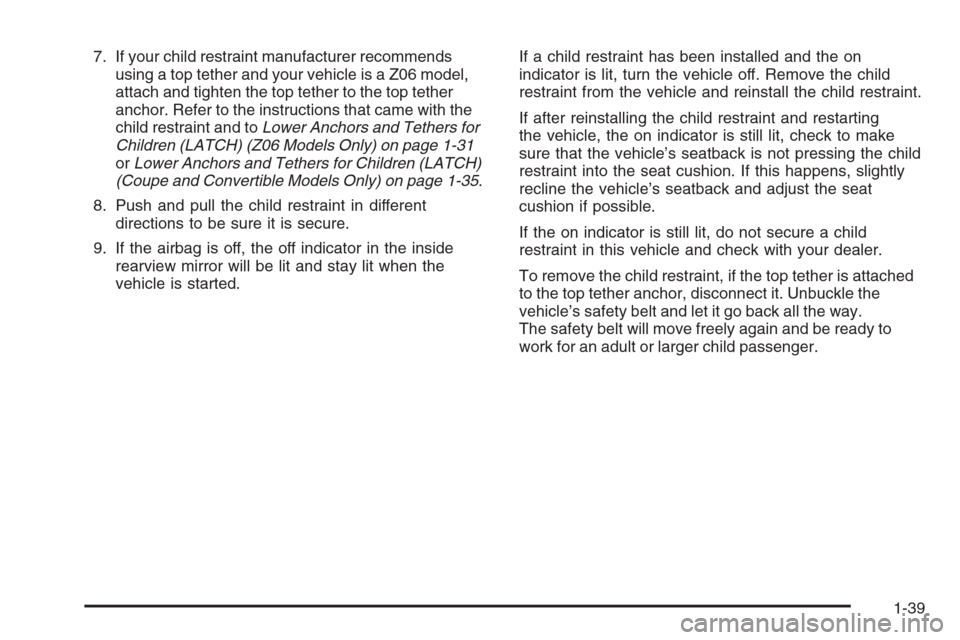
7. If your child restraint manufacturer recommends
using a top tether and your vehicle is a Z06 model,
attach and tighten the top tether to the top tether
anchor. Refer to the instructions that came with the
child restraint and toLower Anchors and Tethers for
Children (LATCH) (Z06 Models Only) on page 1-31
orLower Anchors and Tethers for Children (LATCH)
(Coupe and Convertible Models Only) on page 1-35.
8. Push and pull the child restraint in different
directions to be sure it is secure.
9. If the airbag is off, the off indicator in the inside
rearview mirror will be lit and stay lit when the
vehicle is started.If a child restraint has been installed and the on
indicator is lit, turn the vehicle off. Remove the child
restraint from the vehicle and reinstall the child restraint.
If after reinstalling the child restraint and restarting
the vehicle, the on indicator is still lit, check to make
sure that the vehicle’s seatback is not pressing the child
restraint into the seat cushion. If this happens, slightly
recline the vehicle’s seatback and adjust the seat
cushion if possible.
If the on indicator is still lit, do not secure a child
restraint in this vehicle and check with your dealer.
To remove the child restraint, if the top tether is attached
to the top tether anchor, disconnect it. Unbuckle the
vehicle’s safety belt and let it go back all the way.
The safety belt will move freely again and be ready to
work for an adult or larger child passenger.
1-39
Page 48 of 426

{CAUTION:
Anyone who is up against, or very close to,
any airbag when it in�ates can be seriously
injured or killed. Airbags plus lap-shoulder
belts offer the best protection for adults, but
not for young children and infants. Neither the
vehicle’s safety belt system nor its airbag
system is designed for them. Young children
and infants need the protection that a child
restraint system can provide. Always secure
children properly in your vehicle. To read how,
seeOlder Children on page 1-22andInfants
and Young Children on page 1-25.
There is an airbag
readiness light on
the instrument panel
cluster, which shows
the airbag symbol.
The system checks the airbag electrical system for
malfunctions. The light tells you if there is an electrical
problem. SeeAirbag Readiness Light on page 3-34
for more information.
Where Are the Airbags?
The driver’s frontal airbag is in the middle of the
steering wheel.
1-42